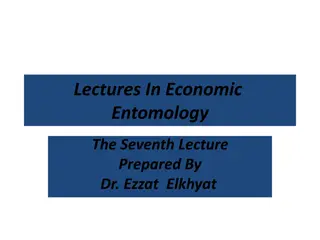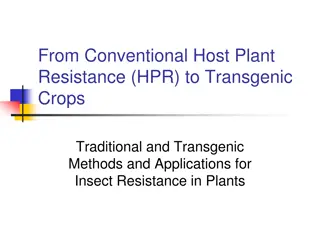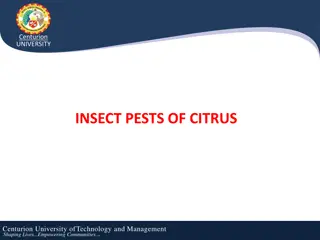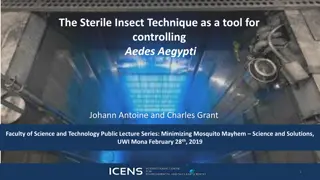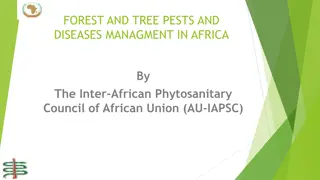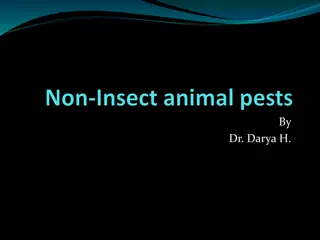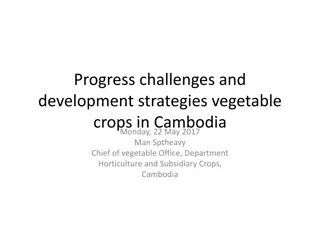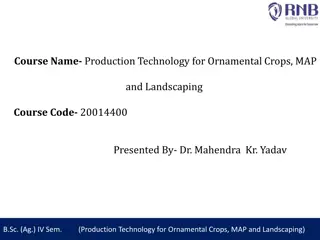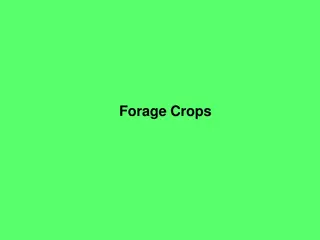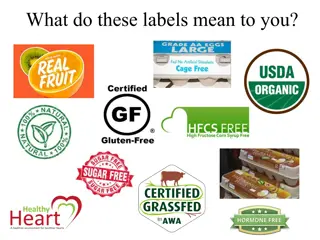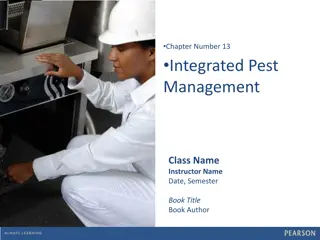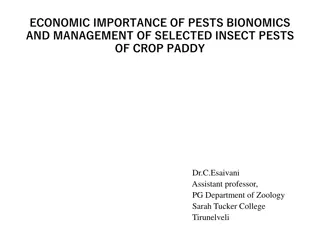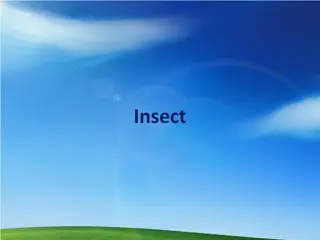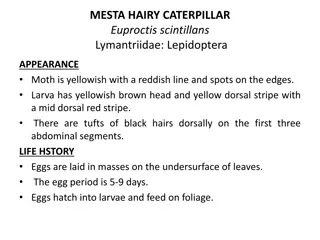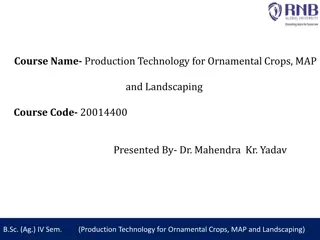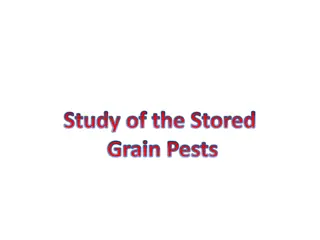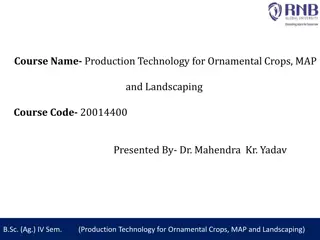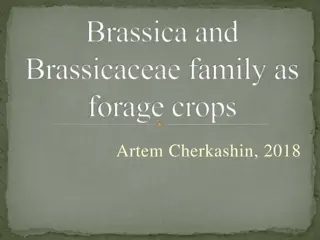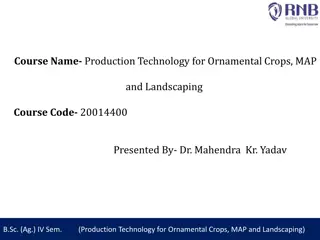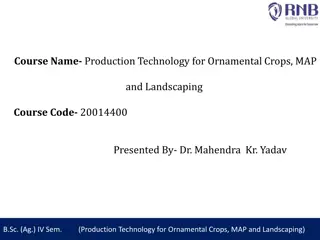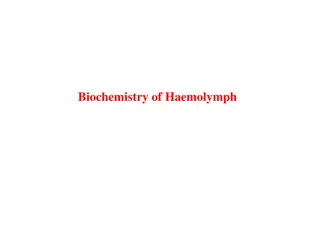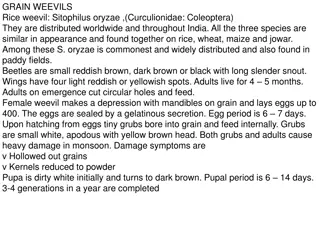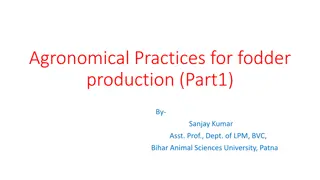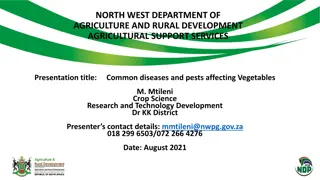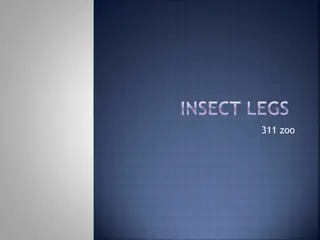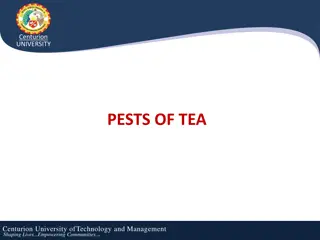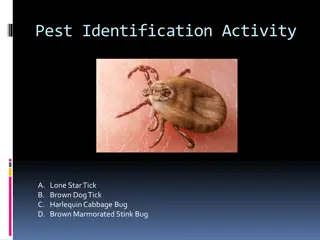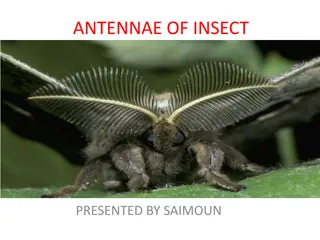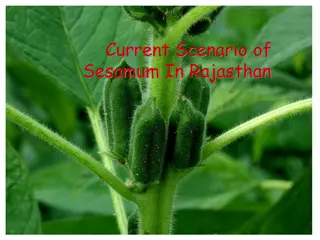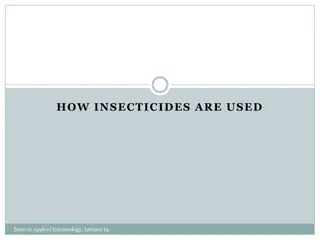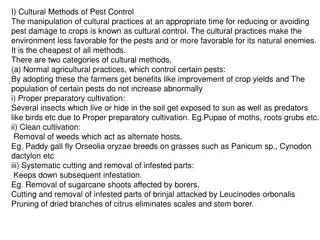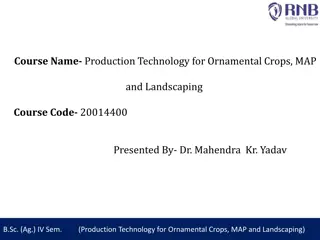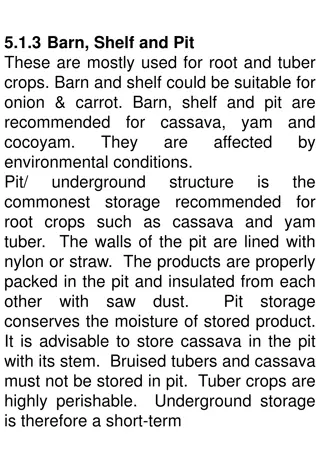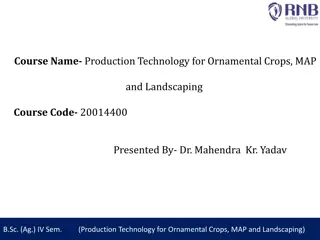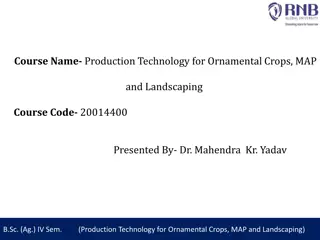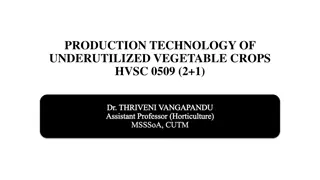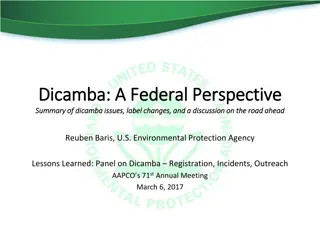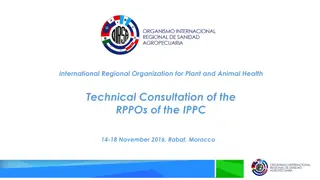Bionomics and Management of Insect Pests in Crops: Insights and Strategies
Explore the bionomics and management practices for key insect pests affecting crops like pulses, brinjal, and tomato. Learn about the life cycles, damage caused, and effective control measures for pests such as the greasy cutworm and plume moth.
Download Presentation

Please find below an Image/Link to download the presentation.
The content on the website is provided AS IS for your information and personal use only. It may not be sold, licensed, or shared on other websites without obtaining consent from the author. Download presentation by click this link. If you encounter any issues during the download, it is possible that the publisher has removed the file from their server.
E N D
Presentation Transcript
BIONOMICS AND MANAGEMENT OF SELECTED INSECT PESTS OF CROPS PULSES, BRINJAL AND TOMATO Dr.C.Esaivani Assistant professor, PG Department of Zoology Sarah Tucker College Tirunelveli
Pest of pulses 1. The greasy cutworm Occurrence It occurs throughout India as a major pest on rabi- crops and selectively attacks the seedling and vegetative stages, particularly, of gram. Host complex Gram, peas, cowpeas, cotton, potato, wheat, tobacco, chillies, brinjal, cucurbits and other vegetables.
Life history Short and long cycle in summer and winter, respectively. The female lays about 30-40 spherical eggs in cluster on the lower surface of leaves lying close to the ground. Afemale lays about 1000 eggs during her life. Incubation period 4-7 days. 5 larval period 4 to 6 weeks.
The full grown caterpillar is 4.6 cm long dark brown. The first instar caterpillars are the semiloopers and get coiled at middle during day crawling. The caterpillars are nocturnal and hide in the soil cracks or waste vegetation during day time. The last instar larva undergoes pupation inside the soil cracks after preparing the earthen cocoon. Pupal period 10-13 days in summer, 30 days in winter. The moths are dark-brown in color, 25mm long with a wing-span of 40-55 mm. They are the great fliers. Fore wings with long dark grey patches. The adult hide under the leaves, cracks and crevices during daytime and active during night. They migrate in swarms from hilly areas to the plains during October. Two generation per season. One generation period 5-9 weeks.
Damage The caterpillars cut the leaf branches or shoot at the base and destroy the crop heavely. They feed on foliage during night. They damage plants more than they eat. Control Primary measures : clean cultivation, ploughing the soil and breaking the sods. Cultivation of heaps of green grass to trap the caterpillars and removing the grass regularly. Hand picking at large scale. Flooding the area. Use of poison baits. Collection of adult moths by light trap. Chemical measures : 5% heptachlor or chlordane dusting at the rate of 30-40 kg/hectare. Sprays of carbonyl or endosulfan or application of any available contact insecticide is recommended. Biological measures : Larvae may be parasitized by Microgaster, Bracon kitcheneri etc. some insects, such as Broscus punctatus and Liogryllus bimaculatus are their predators.
The plume moth Exelastis atmosa, walshingham (Lepidoptera:pterophoridae) Occurrence All over India, New Guinea etc. Host complex Red gram, pigeonpea, horse-gram, lablab and pea.
Life history The females lays minute, yellowish green eggs singly or in cluster on tender pods, buds, shoots, leaves and flowers. She lays about 100 eggs during her life. Incubation period 2-5 days. Larval instar 5. Larval period 10-25 days. The full grown larva is about 1.25 cm long, and greenish brown pods. Pupa is covered with hairs. Pupal period 18-45 days. Moths are slender, 7 mm long with a wing span of 15 mm. they are greenish brown plume like moths. The wing margin is fringed and looks like plumes.
The caterpillars first scrap the pod surface, bore and thrust head inside the green pods and unopened buds, flower and feed upon seeds and anthers respectively from outside. It damages 5-20% pods. Control Primary measures : collection and destruction of infested pods. Clean cultivation continuous cropping to be avoided. Chemical measures : Spray of 0.07% endsulfan or synthetic pyrethriod at the intervals of 10 days. Biological measures : Introduction of larval parasites like Apanteles paludicolae, Diadegma etc.
Red gram (Tur-) podfly Melanogromyza obtuse, Malloch. (Diptera:Agromyzidae) Occurrence All over India,America, Europe,Australia, New Zealand etc. Host complex It is a major pest of red gram, cowpea, soyabean and ather members of leguminacae during rabi season.
Life history Females lays about 30-80 eggs inside the pods by piercing her ovipositor, a single minute egg is deposited per pod. A female lays 40-80 eggs during her life. Incubation period 3-5 days. The maggots initially feed on mesophyll of the leaf and forming a zig-zag gallery. They feed on pods subsequently. The larva period 8-12 days. The last instar maggot is creamy white in color and 3-4 mm in leanth. The pupation occurs inside a brown colored cocoon prepared inside the pods and adult emerges after drilling a hole. Pupal period 6-10 days. The adult flies are very small, metallic, blackflies, about 1.5 mm in leanth and with a wing span of 4 mm. proboscis is brown at the apex. The adult are short lived. One generation is completed in about 3 weeks. Several generation per year.
Damage The maggots after hatching, start mining and under surface of pods and then burrow and feed the seeds internally. They form deep burrows and gallaries. They migrate from pod to pod. It causes 60% damage to the pods of red gram. Control Primary measures : Collection and destruction of damaged pods. Chemical measures : Spraying with any contact insecticide, 0.07% endosulfan followed by 0.04% monochrotophos during the early infestation at flowering and pod forming stages. Biological measures : Larval parasite Euderusagromyzae and pupal parasites Euderus livides and Eurytoma check thepopulation of the pest in nature.
The gram pod borer (American cotton bollworm) Helicoverpa (Heliothis) armigera Huebner. (Lepidoptera:Noctuidae) Occurrence Cosmopolitan, Heliothis zea is native of U.S.A. Exotic pest in India tropics and subtropics. In India, active during November March. Host complex Gram, red gram, peas, cotton, tomato, tobacco, ganja, safflower etc. polyphagous pest.
Life history Female lays spherical, greenish yellow eggs singly on leaves, shoot and other tender parts of a plant. Each female lays about 700 eggs during her life. Incubation period 2-4 days. The first instar larva enters the pod, feed on grains and later instars develop inside. While feeding their body is lying outside. Larval period 12-20 days. Full grown larva is about 35 mm long, green with longitudinal grey stripes laterally. Last instar drops down on the soil and pupation occurs in earthen cocoon in the soil. Pupal period 7-15 days. It undergoes hibernation during winter. The adults are large, stout, oliver-grey, reddish brown colored moths. They are 20 mm long with 30-40 mm wing span. Fore wings are light brown in color having black spot at the centre and v-shaped and dark area near outer margin and hind wings are light dull colored with dark outer border. Generations 8 per years.
Control Primary measures : Hand picking of the caterpillars at initial stage of infestation. Plouhing the field after harvest. Chemical measures : Spraying of carbaryl or endosulfan is generally recommended. Synthetic pyrethroids are now a days commonly used. Biological measures : Some attempts are made to control the pest by introducing egg-parasite- Trichogramma confusum, larval parasite- Bracon kitcheneri, Banchopsis ruficornix, Goniophthalmus halli etc. pupal parasite-G.halli and carcelia illota.
Redgram (tur) pod bug Clavigralla gibbosa spinola (Hemiptera:Coreidae) Occurrence UP, M.P, Maharastra, Punjab and other parts of india, abundant during October may. Host complex Red gram, (pigeon pea), lablab, cowpea etc.
Life history Female lays clusters off 3-15 eggs on leaves or pods. Single female lays about 400 eggs. Incubation period 8-12 days. Nymphal instars 5. Nymphal period 17 to 30 days. Adults are tiny, reddish green hoppers with prominent lateral spines. Adult life 6 days. Adult are about 2cm, greenish brown and with a spine on pronotum.
Damage Nymphs and adults feed on growing pods causing yellow patches and shrivel up, and cause formation of reduced size of grains. Control Primary measures : Collection and destruction of the infested pods. Removal of adjoining leguminous crops, particularly that of pigeon- pea. Chemical measures : Insecticides, like monocrotophos (0.04), metasystox(0.03) or lindane (0.1). Biological measures : Eggs are parasitized by gryon antestige (Hymeno) and nymphs and adults by yhe mite, Bochartia.
Brinjal Shoot and root borer Leucinodes orbonails guen. (Lepidoptera:Pyraustidae) Occurrence Various parts of india. It becomes serious just after transplantation. Host complex Brinjal and sometimes on potato (stem borer).
Life history Eggs-female lays singly abought 150-250 eggs of while color, on underside of the leaves, buds, calyces of the fruits etc. incubation period 3-5 days. Larval-instar-5. Larval period 14-20 days. The fruit instar tiny caterpillar bores the petiole, tender stem or fruit or flower buds and entire larval development occurs inside the stem or the fruits. The fully grown caterpillar is pale-white with violet spots arranged in linear fashion on the body. At last, it comes out for pupation. Pupation within a boat-shaped grey cocoon attached with stem or fruit externally or under fallen leaves. Pupal period 7-11 days. Adult life about 5 days. Moths with white wings. There are pink-brown patches over the dorsal surface of fore wings. Head and thorax are dark brown. They survive for a week. Generation-overlapping.
Damage Being stem borer, larvae are internal feeders of the stem causing shoots to bend down and wither. One fruit may be infested by large number of larvae. Large holes are the exit openings of the last instar caterpillars for pupation. Control Primary measures: Removal and destruction of infested fruits and bended shoots. Cropping of tomato and potato by rotation. Cropping of a variety with long tubular fruits in the place of that with spherical fruits. Chemical measures: Spraying with 0.1% carbonyl, quinalphos, endosulfan, chlorpyriphos at regular intervals of 7-10 days. Biological measures : Larval parasites, Bracon, Pristomerus cremastus etc. lower down the pest level.
Tomato The fruit borer (Heliothis armigera: Noctuidae, Lepidoptera) The larvae bore into tender fruits and make them unfit for consumption. The eggs are laid on tender shoots, leaves and fruits singly. The larvae attack tender leaves and fruits.
Control Spray application of endosulfan on carbaryl or fenvalerate or cypermethrin control the pest.
The cutworm (Spodoptera litura:Noctuidae, Lepidoptera) This insects known as the tobacco caterpillar, attacks the tender leaves and tender fruits of tomato. The damaged fruits become unfit for consumption. The larvae remain concealed during day time in crevices in the soil and become active late in the evening. Control measures as under fruit borer.
The spotted beetle (Henosepilachra vigintictopunctata:Coccinellidae, Coleoptera). Generally coccinellids are predaceous on other insects but members belonging to the genus Henosepilachna are Phytophagus feeding on plants. The spotted beetle is another important pest of tomato, causing defoliation and drying of plants in care of a severe attack. Life-history and control as under brinjal.
Economic Threshold The economic threshold is probably the best known term and most widely used index in making pest management decisions. The ET indicates the number of insects (density or intensity) when management action should be taken. For this reason, it is sometimes called the action threshold. Although expressed in insects numbers, the ET is realy a time parameter, with pest numbers being used as an index for when to implement management. Just as with EILs, ETs also can be expressed in insect equivalents.
If a pest population is growing as the season progresses, growth rates are predicted, and the ET is set below the EIT. By setting the ET at lower value, we are predicting that once population reaches the ET, changes are good that it will grow to exceed the EIL. Therefore, it is appropriate for us to take action on an earlier date(before we accrue losses in reaching the EIL). Where it can be seen that action was taken when a population level exceeded the ET, and the population was forced down before it could reach the EIL. No action was taken at levels below the ET.
From this discussion, it should be clear that the ET is a complex value. It is based on the EIL, a value of economics and potential for injury. However, it also relies on an understanding of population dynamics because potential growth rates need to be predicted. In instances where population dynamics are poorly understood the ET may be set equal to the EIL or arbitrarily below it. An ET lower than the EIL has the great advantage of giving us time to respond to a problem developing in a field or other habitat. For the previous with an EIL of 5 insects/plant, we might set the ET at 4 insects/plant to obtain added reaction time and avoid some of the early losses.
Thank Thankyou you


